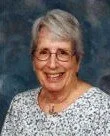November 11, 1917 – December 27, 2008
by Barbara Sue Oglesby Nicholl, St. Stephen’s Episcopal Church, Erwin, 2016
Pauline Jewel Faulkner Ralph
If there was ever anyone who appreciated God as the creator of the universe, and who took it on as her responsibility to keep our earth green, it was Pauline Ralph. She was appointed by the mayor of Erwin, NC to develop a tree board so that Erwin could become a Tree City USA. Over many years, she was responsible for many trees being planted in Erwin in memory of persons who had been influential in the community. To honor her many years of dedication, in the year 1998, citizens of Erwin planted 12 trees in her honor in the Erwin park.
Pauline not only cared about the earth, she cared about her church, St. Stephen’s Episcopal Church in Erwin. Pauline knew that there was more to being a member of a church than just coming to church. She not only came to church, every Sunday and every Wednesday, or whenever the church doors were open, but did much more. Pauline could tell you the history of the church over a period of 70 years. She didn’t just keep all these things in her heart, she shared them. To Pauline, talking about her church and talking about God was the easiest and most natural thing in the world.
Pauline was reared a Baptist. In 1936, she married Frank Kitchener Ralph, a member of St. Stephen’s since his birth, and she became a member of the Episcopal Church. The couple had four children, Diane, Sandra, Frank and Daniel, each of whom spent all or some of their adult life at St. Stephen’s. Pauline’s service orientation was evident early. Looking back at vestry minutes from 1944 and 1945, Pauline, as President of the Women’s Auxiliary, spearheaded a “used clothes drive for people in liberated countries of Europe” and programs included “Reports of missionaries recently returned from enemy or occupied countries.”
In the Episcopal Church, adults often don’t see the need for adult Sunday School. Pauline did. She was a faithful Sunday School member. She could tell how God had helped her and how God spoke to her heart. Pauline was forward looking and always on the forefront of new ideas. She was the first woman lay reader and chalice bearer at St. Stephen’s. She took communion to the sick and made sure that each person who could not get to church had communion taken to them.
Pauline was a Licensed Practical Nurse, bookkeeper for her husband’s business, real estate broker, Mary Kay salesperson, and newspaper reporter. She served as president of the Erwin Chamber of Commerce and was voted Erwin’s Woman of the Year in 1988.
Pauline served on the Vestry, was president of the ECW again in 1989, was an EYC leader, and was a faithful member of the choir for over 60 years. Today several of her great-grandchildren, Jacob, Thomas, Paul, Kannan and Olivia serve as acolytes at St. Stephen’s. In 2008, after many years of faithful service and at the age of 91, Pauline went to be with her Lord.





